
FCBarcelona
.pdf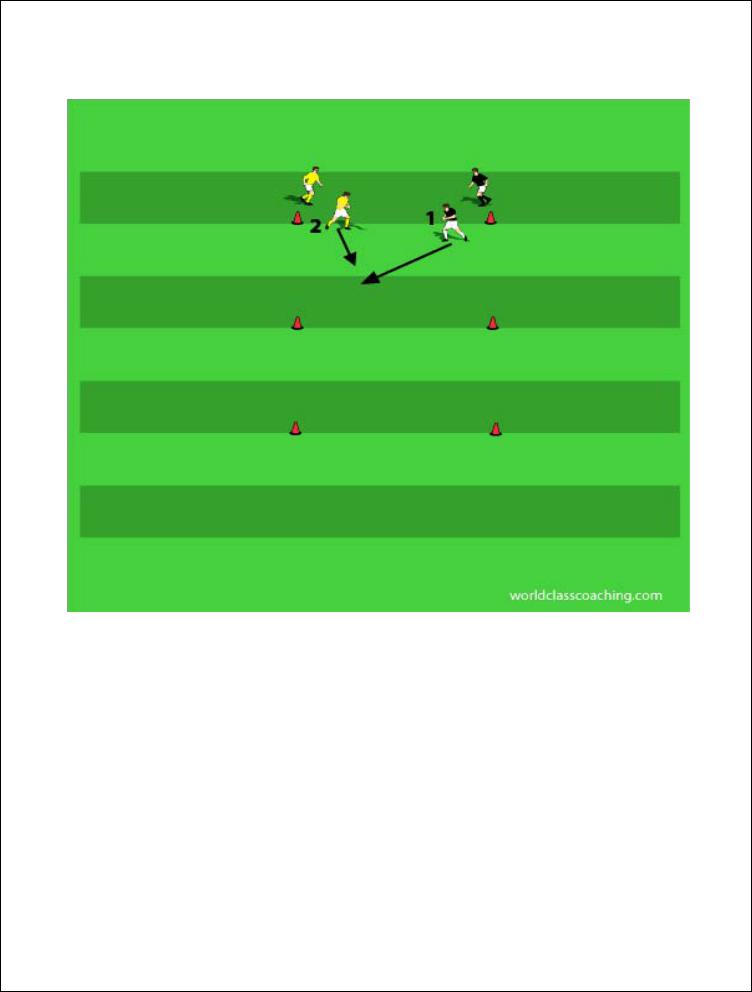
Progression:
Player 1 gets in a defending position in front of player 2 (no ball). Player 2 jogs forward, changing speed and direction (zig-zag), but allowing the defender to remain in front of her throughout. When the players reach the end of the chute, they step to the outside and jog back to their respective lines
Coach:
•jockeying position. The defender should ‘open’ (turn) her toes, hips and shoulders toward the nearest side of the grid to channel the ball to the tightest area and limit the attackers’ options. This closed position also allows the defender to avoid having the ball played between her feet in live play. The defender should also assure that her weight does not shift to her heels, as it becomes very easy for the attacker to make a quick change of pace or direction and lose the defender if her weight is not on the front of her feet (lean slightly forward, legs bent). Similarly, the defender’s focus must be the ball. Top defenders are not affected by attackers’ body feints because their main focus in a dueling situation is the ball. It is useful to encourage defenders to get their eyes closer to the ball to emphasize this point. It is important not to get too carried away with this point, as a defender too low and leaning too far forward is also easily beaten with a quick touch away. Hand/arm position is also a consideration. Flailing arms can be a source of imbalance and fouls. Top defenders keep their arms and hands comfortably at their sides (some
©WORLD CLASS COACHING |
Page | 80 |
FC Barcelona – Style and Domination |
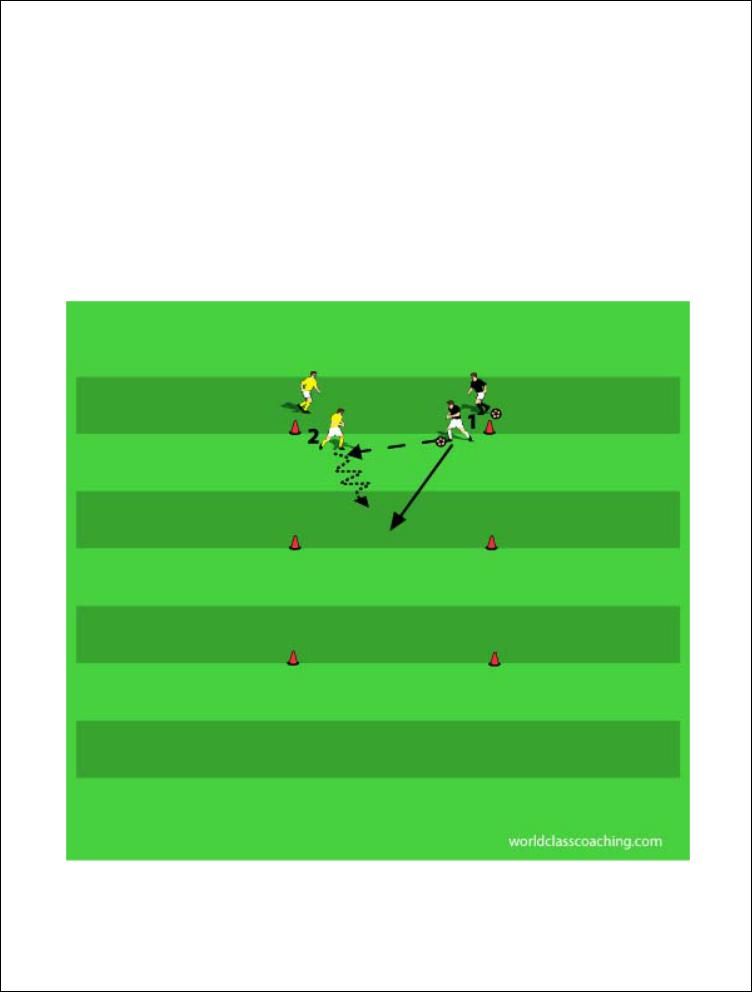
coaches like the defender to hold the bottom of her shorts with the hand nearest the ball to avoid handball calls…) while jockeying. Finally, mentality is critical to quality defending. Passive performance in jockeying exercises often means poor performance in dueling situations. Someone once said that any player transitioning to defense has to, ‘Hunt the ball.’ One of the easiest ways to separate players at tryouts is to watch them defend as individuals. Top players will want to win the ball and will not be satisfied with going through the motions of jockeying and seizing control of a dueling situation.
•jockeying footwork. The defender should use a ‘chop step’, keeping the feet underneath her (short steps). This shorter step both increases balance and also allows the defender to make quick adjustments to the ball as the attacker begins her run. Finally, the defender’s feet should never come entirely together because at that moment she is vulnerable both of balance and also because she likely has weight on both feet, meaning she will not be able to be powerful in adjusting to the attacker’s movement of the ball.
•recover and jockey. Player 1 passes to Player 2 and then makes a recovery sprint to get into good defending position. Player 2 allows the defender to get placed and then dribbles in a zig-zag
©WORLD CLASS COACHING |
Page | 81 |
FC Barcelona – Style and Domination |
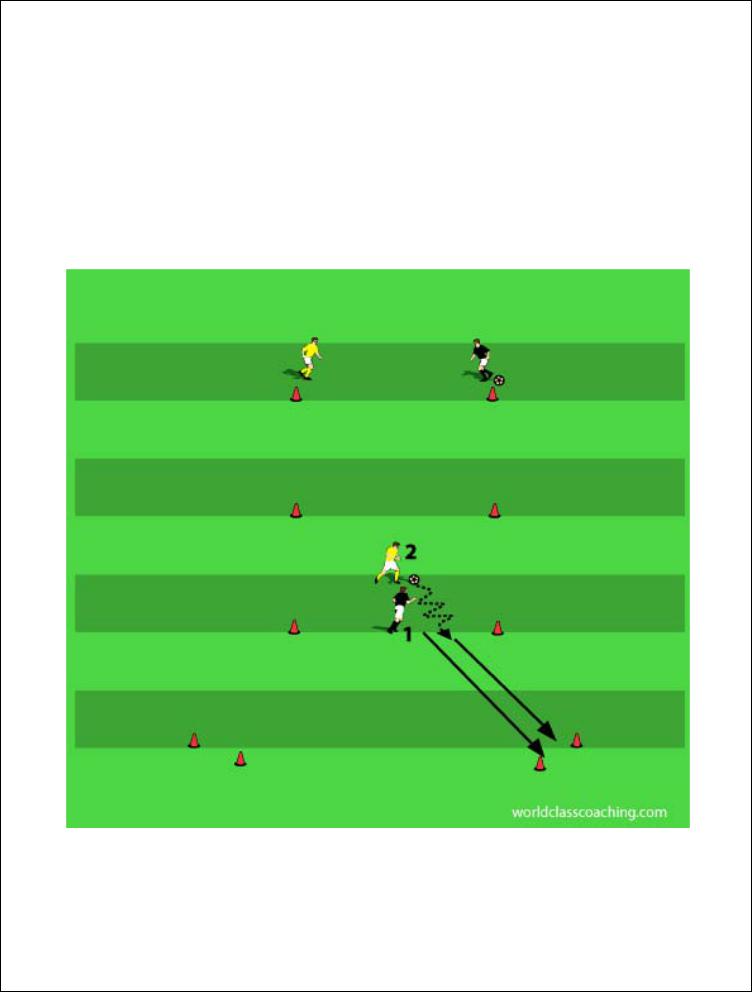
pattern, not attempting to get behind the defender, but forcing her to constantly deal with changes in direction and speed, as well as fakes. When the players reach the end of the chute, player 2 dribbles the ball back to her starting point and the players change roles the second time through the chute.
Coach:
•after passing the ball, the defender must accelerate to get into a good defending position. The first steps need to be powerful and short, allowing the defender to close quickly and also adjust to any movement of the ball.
•focus on the ball. Now that there is a ball in play (no tackling!), the defender can be coached to focus on the ball throughout the exercise.
•jockey and sprint. Player 1 passes to player 2 and then makes a recovery sprint to get into good defending postion. Player 2 allows the defender to get placed and then dribbles in a zig-zag pattern, not attempting to get behind the defender, but forcing her to constantly deal with changes in direction and speed, as well as fakes. When the attacker reaches the end of the chute, she
©WORLD CLASS COACHING |
Page | 82 |
FC Barcelona – Style and Domination |

makes an explosive run (leave the ball at the end of the chute) through one of the two gate goals. The defender must attempt to be the first player through the chosen gate. When the players reach the end of the chute, player 2 dribbles the ball back to her starting point and the players change roles the second time through the chute.
Coach:
•awareness. The defender must be aware of the space and options available to the attacker as the pair near the end of the chute. The defender should attempt to pin the attacker to one side of the chute, forcing her through the near-side gate.
•physical aggressiveness. At the moment the attacker tries to get in behind the defender, the latter must move to cut off the former’s run. If necessary, she should also ‘swim’ (use her arms to get shoulder-ahead to the goal) to assure that she gets primary position. Encourage players to be very aggressive in asserting themselves in this situation.
•explosive running. One of the most challenging aspects of marking is to deal with a sudden run at speed off of the ball by an attacker. In this exercise, the defender has to recognize the moment to sprint through the gate. She is already at a disadvantage in that she does not know which route the attacker will choose (similar to patterns in the game) and because she is facing away from the goal while the attacker is faced up with her destination.
©WORLD CLASS COACHING |
Page | 83 |
FC Barcelona – Style and Domination |
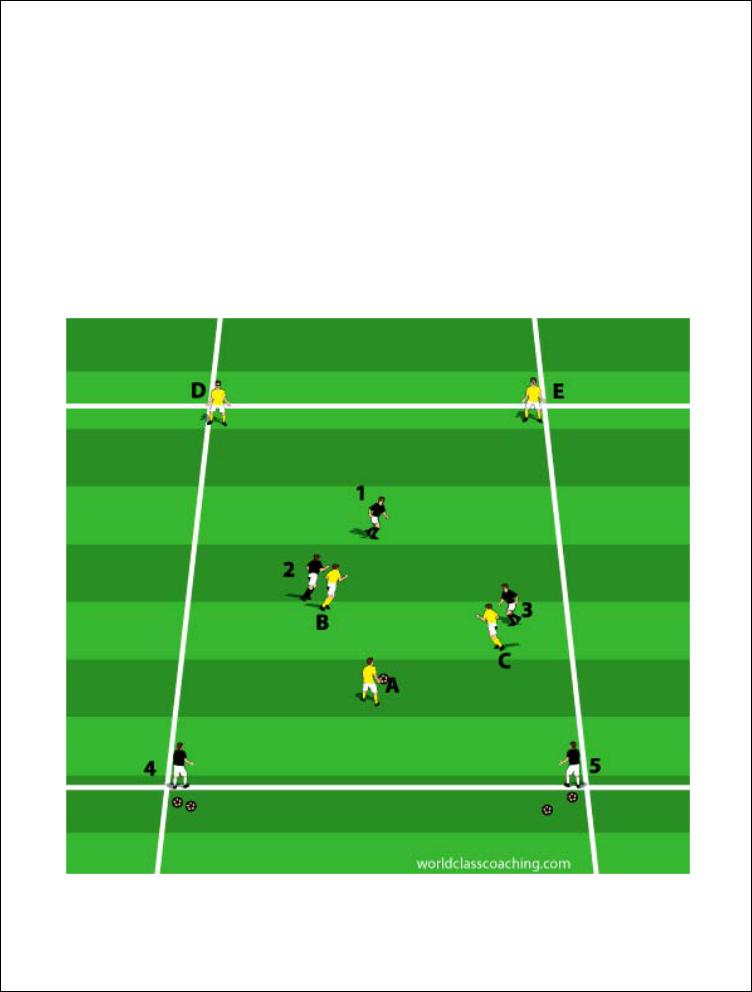
4 vs 4 functioning as 4 vs 2 (2) 15x20 yard grids Each team of four begins inside one of the neighboring grids as shown. Restarts come from the ball supply shown at the side of the grid. The goal of the exercise is to win possession in the opponent’s grid, return the ball to one’s own team grid and keep possession. In the first phase, two players from the defending team can cross into their opponents’ grid to try to win back the ball. The reasons for starting with two defending players are to impress upon the players the importance of applying pressure when outnumbered and also to get them to think in terms of small group tactics (i.e. first and second defender roles).
Coach:
•high pressure defending. This game is played in a relatively small space and offers the defenders the opportunity to quickly cordon off and pressure the ball. The defending should be in relatively short stints (as in the real game) and furious in intensity.
3 vs. 3 +4 |
20x25 yard grid |
Two midfield triangles (1, 2, 3 and A, B, C) |
|
play against one-another in a directional small-sided game. For the sake of simplicity and consistency, |
|||
©WORLD CLASS COACHING |
Page | 84 |
FC Barcelona – Style and Domination |
|

both are shown here with a single holding midfielder and two attacking midfielders, though a reverse setup could also be utilized. 1, 2, and 3 try to gain possession and play into the feet of 4 and 5. Similarly, A, B and C try to play into the feet of D and E. The perimeter players cannot play to each other, cannot be tackled and cannot enter play. When 1, 2 and 3 are in possession, they can use D and E for support. To speed up the game, limit the touches or time on the ball for the perimeter players. Also, encourage the attacking team to be creative and not feel constrained to stick to a certain shape.
Coach:
•communication and awareness. Because their roles are so fluid and the space they work in so large, and because the game comes at them from every direction, the midfield triangle need to be constantly sneaking glances at the developing tactical picture (i.e. the positions of their teammates and opponents, etc.) and also verbally identifying their intentions and imperative information (i.e. first and second defender roles, the runs of opponents, etc.).
the shape of the defending triangle. Because the ultimate goal of the team defending will be to funnel balls into the triangle from the front line, the attacking midfielders must be encouraged to get into passing lanes and also mark open players in their midst. Note that in the diagram above, 2 and 3 get on the outside shoulders of their marks (A, B). This posture is intended to channel passes and runners in the direction of the defensive support of player 1, who both covers the attacking midfielders and also marks or cuts out passes to advanced runners.
•intelligent decision-making and high pressure. The defenders’ priorities are:
1.Deny ball.
2.Deny turn.
3.Deny penetrating pass.
4.Deny dribble penetration.
•preventing combination play. The defenders need to anticipate the likelihood of their opponents attempting to play 1-2’s and make overlapping runs to try to carve up or imbalance the defending block. Once again, good communication and tight shape will prevent most combination play from succeeding in this space.
©WORLD CLASS COACHING |
Page | 85 |
FC Barcelona – Style and Domination |
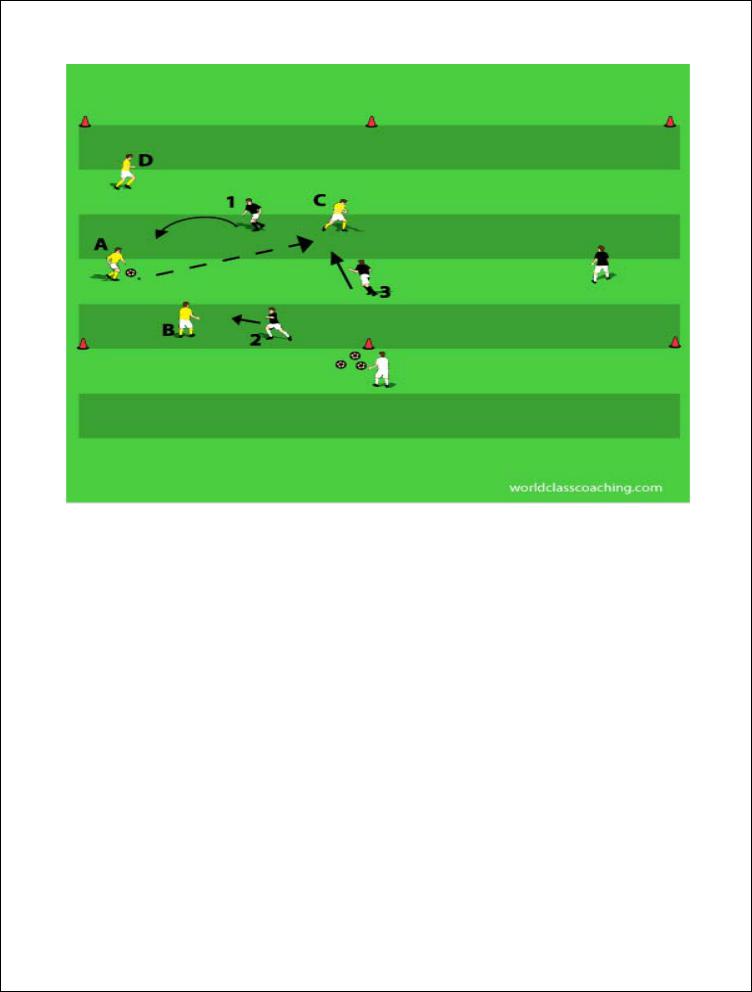
4 vs 4 functioning as 4 vs 3 (2) 15x20 yard grids Now a third forward can join in the defending in the opponents’ grid. Because the area is limited, the defenders will be rewarded for applying high pressure as quickly as possible.
Coach:
•defensive coordination. In addition to rapid transition with the loss of the ball, the forwards must also attempt to work together to isolate, pressure and win the ball and also to understand and coordinate their shifting defensive tactical roles. Young players often need considerable repetition to grasp the importance of visual and verbal communication in channeling and closing down the attacker in possession, particularly when they are the second defender.
•cutting out passing lanes. One of the most important points of awareness to impress upon players is their need to cut out available passing lanes off of the ball. In the example above, player 1 closes down attacker A, while player 2 gets into covering position, taking away the short pass to player B. Player 3 recognizes that the only option available to A is to play a longer pass to C and 3 moves to cut out the pass.
Variation:
•two defenders are allowed into the attackers’ grid at each restart. Restarts are random balls played on the ground or in the air. This variation encourages the forwards to focus on winning balls at restarts, on balls that pop loose in their area of play and also on challenging to win the ball in the area. Point out that high effort and efficiency in these situations can eliminate considerable defending work that is necessary if the opponent is allowed to settle into possession.
©WORLD CLASS COACHING |
Page | 86 |
FC Barcelona – Style and Domination |
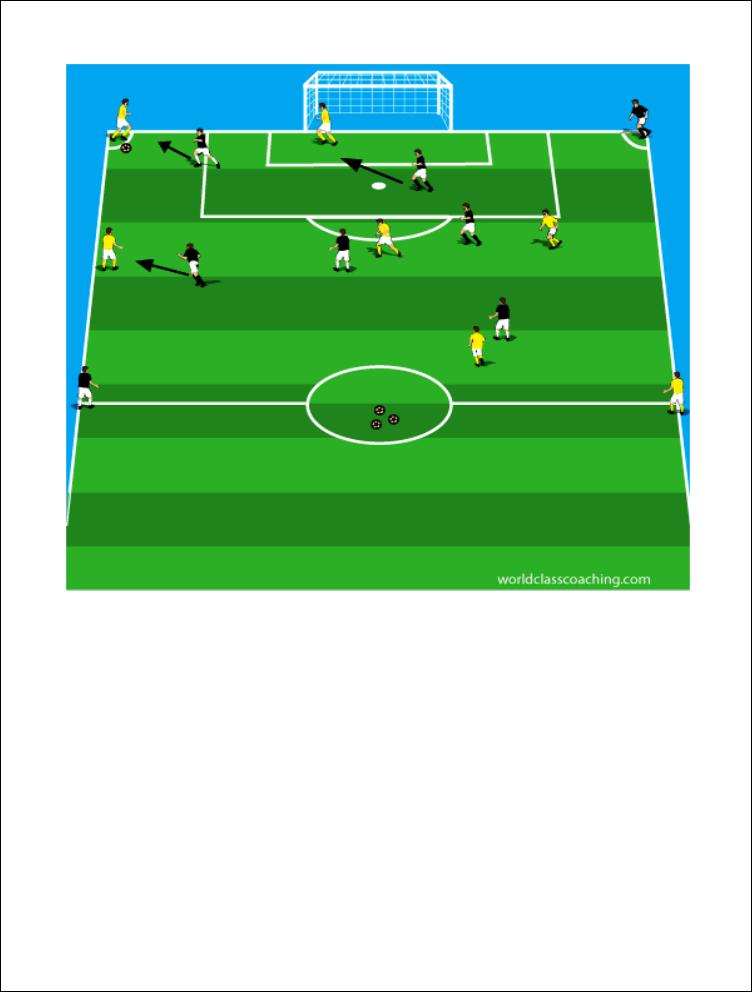
8v8 to corner targets ½ field Each team puts 6 players in the area and one in each of two opposite corners of the grid as shown. Restarts come from the coach at the side of the grid area. This is a possession game in which the teams attempt to play into their target players. Teams must play to alternating corners and after a ball is played in to a corner player, the player passing in takes the position of the target and that player dribbles into the grid, initiating an attack in the other direction. The focus of this exercise, however, is the ability of the defending group to organize to defend. With six players spread over ½ field, the team must apply early and constant pressure to the player in possession from the moment a new attack begins and also provide close support and balance as well. As teams tire, this becomes a difficult task and the coach has the opportunity to reinforce the importance of collective effort and focus in defending.
Coach:
•the first defender. This player must quickly close down the dribbler coming out of the corner after a point is scored. If she does this well, she can take away a long outlet pass and also channel the ball into organizing support underneath the ball.
•condensing space behind the ball. When the first attacker is being closed down, other defenders must quickly take away short passing options and also clog passing lanes to the longer options.
©WORLD CLASS COACHING |
Page | 87 |
FC Barcelona – Style and Domination |
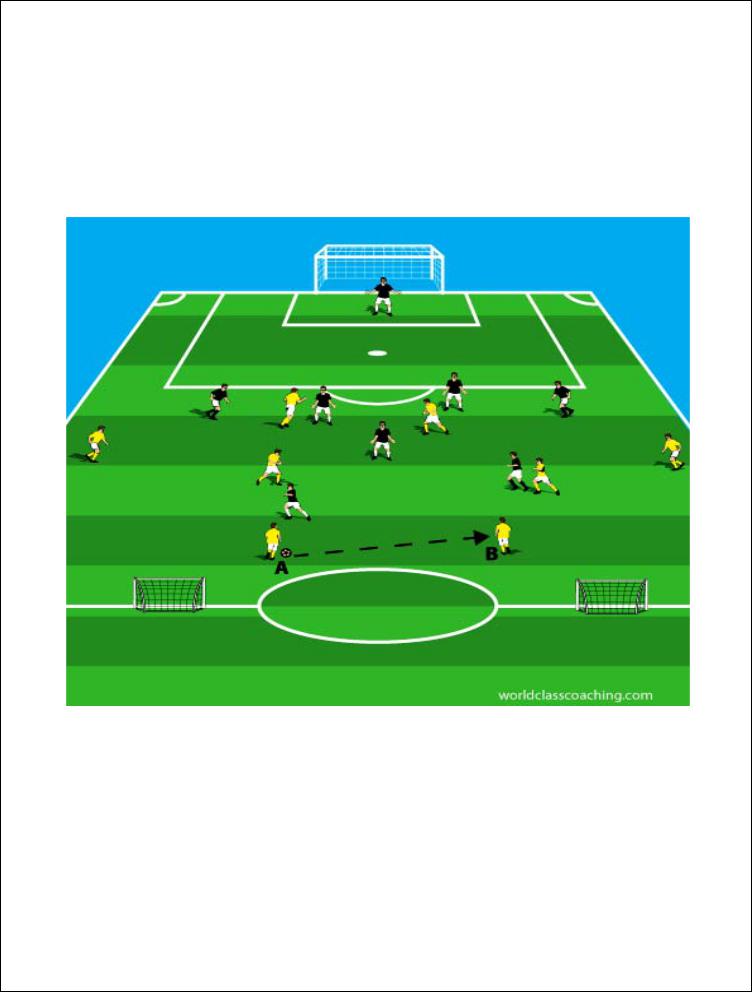
This movement will condense space and give the defenders a better chance of winning back the ball. One or more players behind the ball also balance the defense by guarding against a long ball that would play out the remainder of the team.
•transition. This game typically presents lots of transition moments (shrink the area to emphasize this facet of play) where the team has just won or lost the ball. For the purposes of this game, that moment is key to the defenders applying pressure all over the field and trying to contain and win back the ball immediately.
8 vs. 7+goalkeeper ½ field All restarts in this game are from the attacking center backs (A, B) from a ball supply at midfield. The attackers field two center backs (who can move side-to-side but not forward at this stage), a full midfield with two central midfielders and two flank midfielders, and two strikers. The defenders field a goalkeeper, four backs and a defending triangle. This setting is ideal for teaching defensive cooperation between the back line and the midfield triangle.
©WORLD CLASS COACHING |
Page | 88 |
FC Barcelona – Style and Domination |
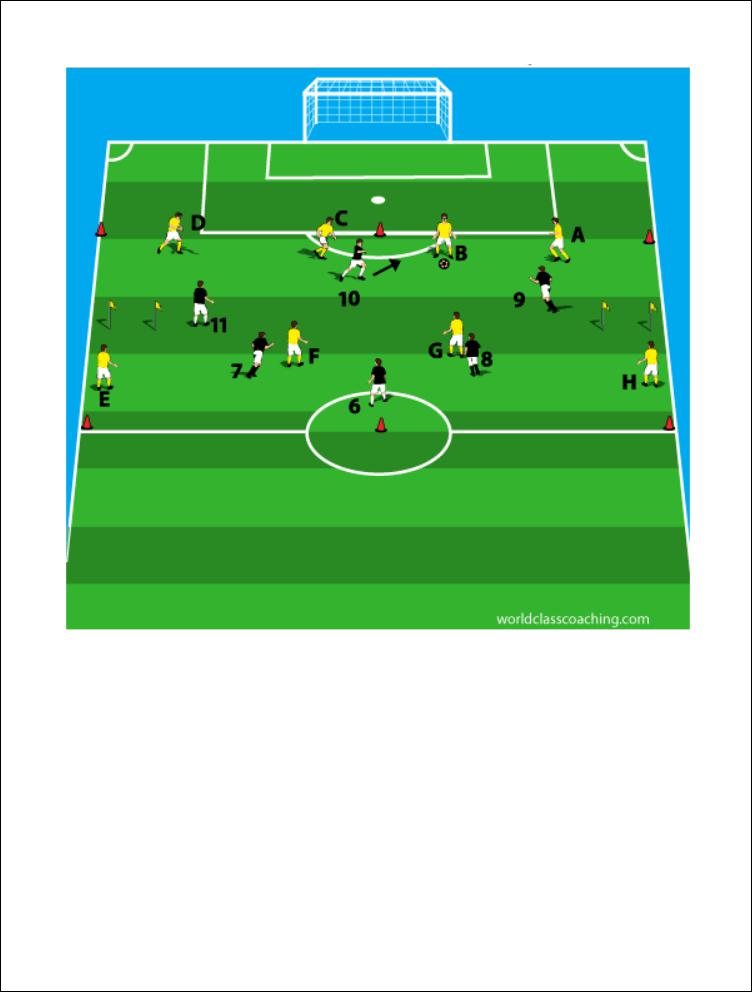
8 vs 6 possession and gates 30x 50 yard area This is a possession exercise designed to set the stage for midfield and front line collaboration in defending in the 4-3-3. The numbers team (6-11) have three central midfielders and three front line players. The letters (A-H) have four backline players and four midfielders (two central midfielders and two flank midfielders). Encourage both teams to maintain their tactical shape. Though there are no goals to play to in this exercise per se, the letters can earn points by playing through either of the flank gates (pass or dribble), while the numbers earn points by tackling the ball (or intercepting a pass to) the opposing center backs or central midfielders).
©WORLD CLASS COACHING |
Page | 89 |
FC Barcelona – Style and Domination |
